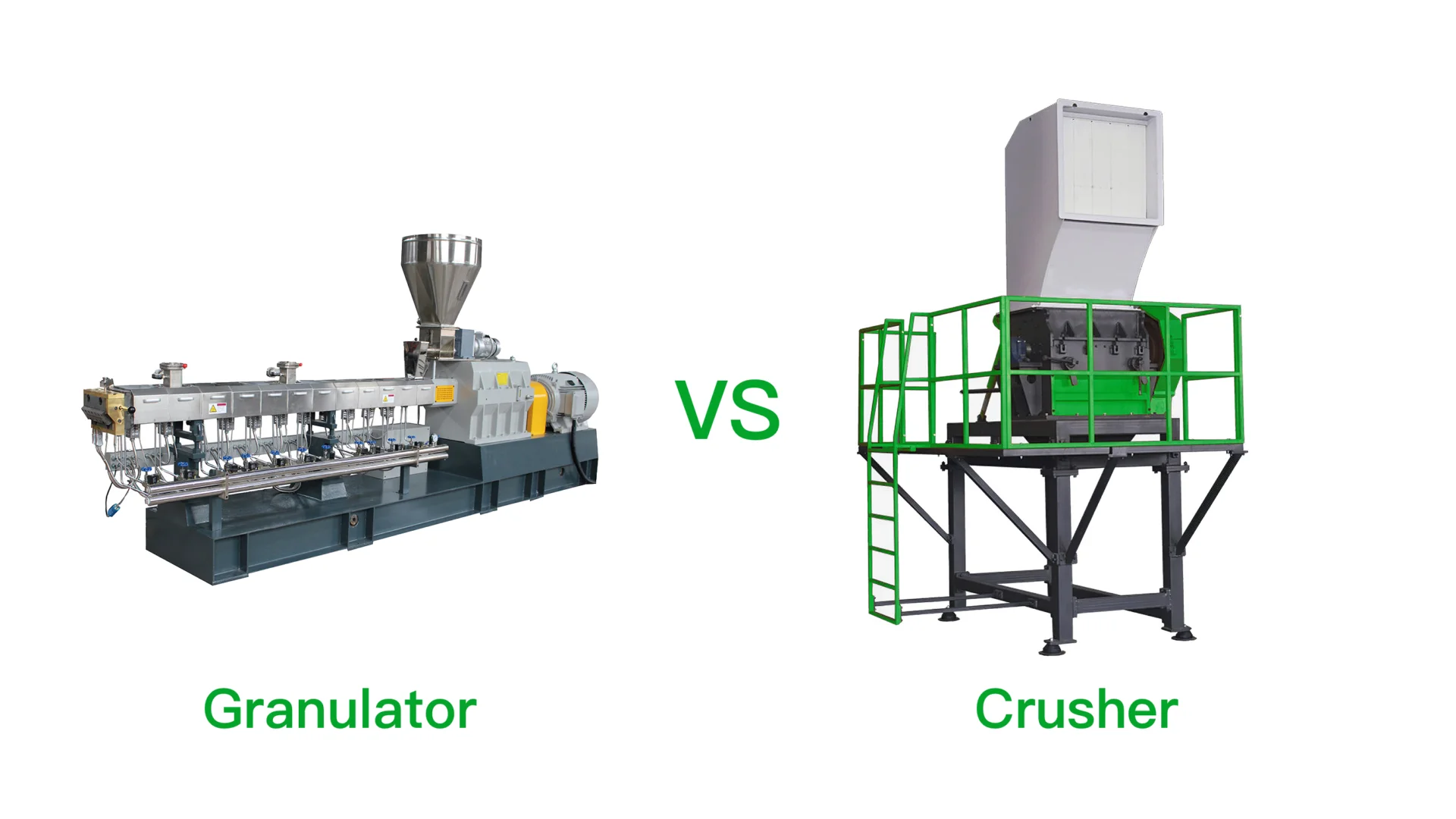Die entscheidenden Werkzeuge im Recyclingbetrieb entschlüsseln
In der schnelllebigen Welt des Recyclings, in der Effizienz auf Innovation trifft, stehen oft zwei Schwergewichte im Rampenlicht: Kunststoffgranulatoren und Kunststoffzerkleinerer. Da der Vorstoß in Richtung Nachhaltigkeit immer stärker wird, ist es nicht nur nützlich, sondern unerlässlich, die Rollen und Unterschiede dieser Geräte zu verstehen. Lassen Sie uns aufschlüsseln, was diese Maschinen tun, warum sie wichtig sind und worin sie sich unterscheiden.
Was ist der Unterschied?
Kunststoffgranulatoren:
Stellen Sie sich ein Gerät vor, das Ihre alltäglichen Plastikgegenstände in winzige, gleichmäßige Pellets verwandeln kann. Das ist Ihr Kunststoffgranulator für Sie. Granulatoren arbeiten durch Schneiden und Scheren und sind die Maschinen der Wahl, um große Kunststoffteile in Granulate zu zerlegen. Diese Granulate werden dann zu den Bausteinen für neue Produkte und verkörpern den Geist der Kreislaufwirtschaft.
Kunststoffbrecher:
Denken Sie an Kunststoffbrecher als erste Ansprechpartner für die Handhabung von Plastikmüll. Diese Maschinen sind Profis darin, Plastikmaterialien durch Zerkleinerungsvorgänge wie Kompression oder Aufprall in kleinere, gleichmäßige Stücke zu zerkleinern. Das Hauptziel dabei? Die Menge an Plastikmüll zu reduzieren, um die Handhabung und Verarbeitung später zu erleichtern.
Was unterscheidet sie?
Betrieb:
Granulatoren und Brecher mögen ähnlich aussehen, aber im Kern unterscheiden sie sich. Granulatoren verwenden scharfe Klingen, um Kunststoff zu zerschneiden, während Brecher Materialien mit Kraft zertrümmern. Dieser grundlegende Unterschied wirkt sich auf alles aus, von der Beschaffenheit des Endprodukts bis hin zur Effizienz des Prozesses.
Ausgabe:
Bei Granulatoren kommt es auf Präzision an. Sie produzieren saubere, gleichmäßige Granulate, die sich perfekt für die Fertigung eignen. Brechersind dagegen etwas robuster und ergeben kleinere, unregelmäßige Stücke, die sich hervorragend für die Weiterverarbeitung oder sogar den direkten Einsatz in einigen Branchen eignen.
Anwendungen:
Aufgrund ihrer unterschiedlichen Verarbeitungsmethoden sind Granulatoren und Brecher in unterschiedlichen Szenarien von Vorteil. Granulatoren sind ideal für das Recycling größerer Kunststoffgegenstände – denken Sie an Behälter und Rohre – und verwandeln sie in Pellets, die sich zum Formen und Extrudieren eignen. Brecher eignen sich hervorragend zum Zerkleinern sperriger Kunststoffabfälle in handlichere Stücke, perfekt für einfacheres Recycling oder Entsorgung.
Einpacken:
Beide Kunststoffgranulatoren und Zerkleinerer sind unverzichtbar, wenn es darum geht, Plastikmüll in wiederverwendbare Ressourcen umzuwandeln. Sie sind entscheidend, um Nachhaltigkeit zu fördern und unseren Planeten sauber zu halten. Indem sie sich damit befassen, wie sie funktionieren, was sie produzieren und wo sie am effektivsten sind, können Recyclingbetreiber intelligentere Entscheidungen treffen und uns einer echten Kreislaufwirtschaft näher bringen.
Sie haben Fragen? Wir haben die Antworten:
- Wähle deinen Kämpfer: Was sollten Sie beachten, wenn Sie sich für einen Granulator oder einen Brecher für Ihren Recyclingbedarf entscheiden?
- Materielle Angelegenheiten: Können Granulatoren alle Kunststoffarten verarbeiten, von steif bis biegsam?
- Sicherheit geht vor: Welche Sicherheitsmaßnahmen sollten Bediener beim Einsatz dieser Maschinen beachten?
- Technischer Vortrag: Wie beeinflussen technologische Fortschritte die Leistungsfähigkeit von Granulatoren und Brechern?
- Globale Auswirkungen: Welche Rolle spielen diese Maschinen bei der Bekämpfung des weltweiten Problems der Plastikverschmutzung?
Durch das Verständnis dieser Handwerkszeuge können sich die Beteiligten in der Recyclingbranche besser auf die Herausforderungen von heute vorbereiten – und den Weg für eine grünere Zukunft ebnen.



